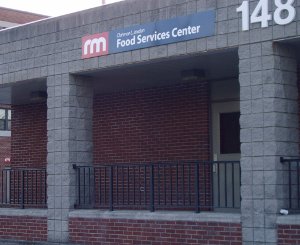
Food banks, like the Rescue Mission (above) in downtown Syracuse, have become increasingly important as the number of people who can’t afford food rises to an all-time high. (Liam Migdail-Smith)
Hunger looms as a threat for a growing number of Americans as the economy worsens.
“We see so many new faces coming in everyday,” said Paul LaDolce, communications director for the Rescue Mission in Syracuse.
In one sign of hunger’s growing threat, 49 million Americans told the Department of Agriculture in a recent survey that they are worried about their food supply. That represents 16 percent of the population, an all-time high in this country.
Consider these statistics:
- Nationally, about 17 million children — or 22 percent of the population —live in families worried about food. That number has risen by 4 million since 2007 — an increase of almost 31 percent, reported the Agriculture Department.
- In New York, 11.3 percent of residents need help putting food on the table, according to the Food Bank of Central New York. That accounts for about 2.2 million people.
- Across the country, 4.8 million households used food pantries in 2008, up from 3.9 million the year before. That is a rise of 23 percent according to the USDA’s survey.
- In Central New York, food pantries served more than 10.8 million meals in 2008, according to the Food Bank of Central New York. That number rose eight percent since 2007.
- In Onondaga County, 27,153 families receive food stamp benefits, according to the Office of Temporary and Disability Assistance. Last year, about 46 percent more families received benefits than in 2007.
At the Samaritan Center in downtown Syracuse, volunteers and staff match faces to those statistics. The Samaritan Center is among several local agencies facing an increase in food requests.
Robert McClure, political science professor at Syracuse University, serves dinner every Tuesday afternoon at the Samaritan Center. He’s been volunteering for 15 years and is also on the center’s board of directors.
“Some of the people have been going through the serving line as long as I have been volunteering,” said McClure. “But there are quite a bit of new faces. More children too.”
In November 2008, the Samaritan Center served 7,374 meals, according to the center’s daily tracking. In November 2009, volunteers served 8,236 meals — an increase of 12 percent.
At the Rescue Mission in Syracuse, volunteers and staff also notice longer lines than in years past. In 2009, the center will serve about 9,000 more meals than in 2008, said Paul LaDolce, its communications director. That’s an increase of about four percent.
“We’ve seen steady increases over the past few years,” LaDolce said.
People worried about food have some options for help:
- Food banks and food pantries
The Food Bank of Central New York supplies about 240 food pantries in 11 counties. A food bank supplies food to its network of individual food pantries. “We give the food we collect to local communities,” said Beth Slater, director of member services for the Food Bank. “Many people would not have much to eat without us.”
Local food-pantry staffs witness trends among those they serve. Mary Beth Frey, of the Samaritan Center, observes longer lines toward the end of each month. “Our numbers increase from beginning to the end of the month as money, food stamps and resources dwindle,” Frey said, “but also as rent, utility and so many other bills come due.”
Economic hardships have hit suburban families the hardest, said Michele Jordan, executive director of the Interreligious Food Consortium in Syracuse. “Increased layoffs have really hurt suburban families,” Jordan said. “Requests from those pantries have really spiked. Sometimes it’s been hard to keep up.”
- Supplemental Nutrition Assistance Program
The Supplemental Nutrition Assistance Program is the new name for the federal food stamps program. Recipients are eligible based on household income, family size and medical expenses. Benefits now come in the form of a plastic electronic card, much like a bank’s debit card. In Onondaga County, about nine in ten of those eligible for food stamps receive benefits, reported the Food Bank of Central New York.
“People are in desperation mode,” said Tracey Clark, nutrition programs coordinator for the Food Bank of Central New York.
Average food stamp benefits last for fewer than three weeks each month. Benefits cover about $1 per meal, per day — just enough for a can of soda.
World Hunger Year, a national non-profit organization in New York City, is an advocate for more funding for food stamps. “People wouldn’t be eating properly without this program,” Bill Ayres, its executive director, said in a phone interview. “Many wouldn’t be eating at all.”
But Brian Riedl, senior federal budget analyst at The Heritage Foundation, criticizes plans to increase food stamp benefits. The Heritage Foundation is a conservative policy think-tank in Washington, D.C.
“Any increase will require higher taxes or enlarge our huge deficit,” Riedl said in a telephone interview. “Probably both.” And that’s not necessary, said Riedl.
The federal government spent $56 billion for food stamps in 2008, Riedl said. Federal spending for food stamps has more than doubled since 2001.
Work requirements are the best reform to food stamps, Riedl said. “People not working is the biggest driver of long-term poverty,” Riedl said. “And it’s nearly impossible to get out of poverty without working.”
Right now, about one in four people receiving food stamp benefits has a job, reports the Food Stamp Outreach Project, a division of the Food Bank of Central New York.
Added Riedl: “I have not seen enough evidence that current benefit levels are insufficient.”
In Syracuse, those on the front lines see it differently. Said Mary Beth Frey of the Samaritan Center: “The choices between food and medicine, rent and heat are real and occurring everyday in our community. Even more so as our economy fights for recovery.”
(Dan Scorpio is a junior with dual majors in newspaper journalism and political science.)
-30-


